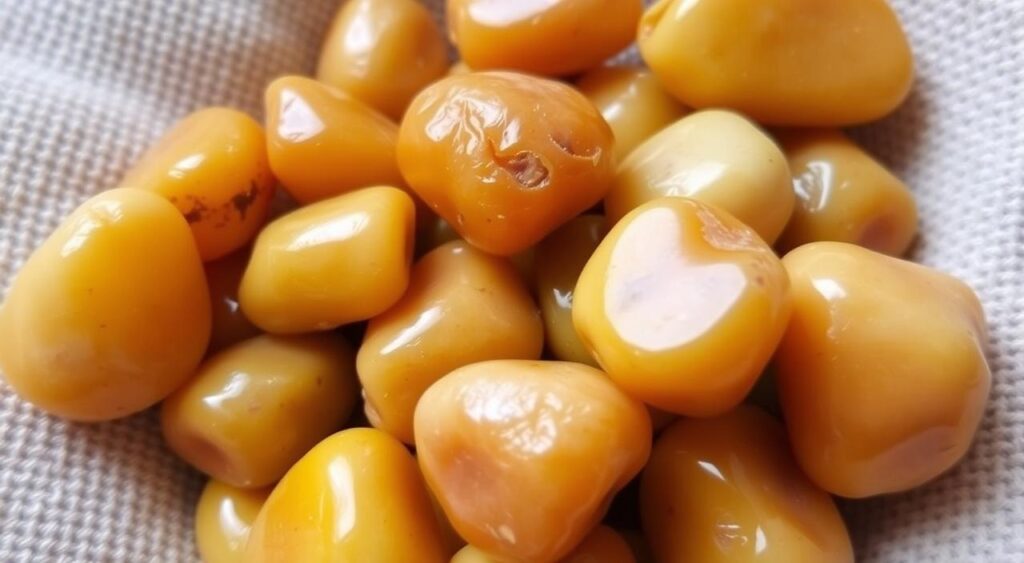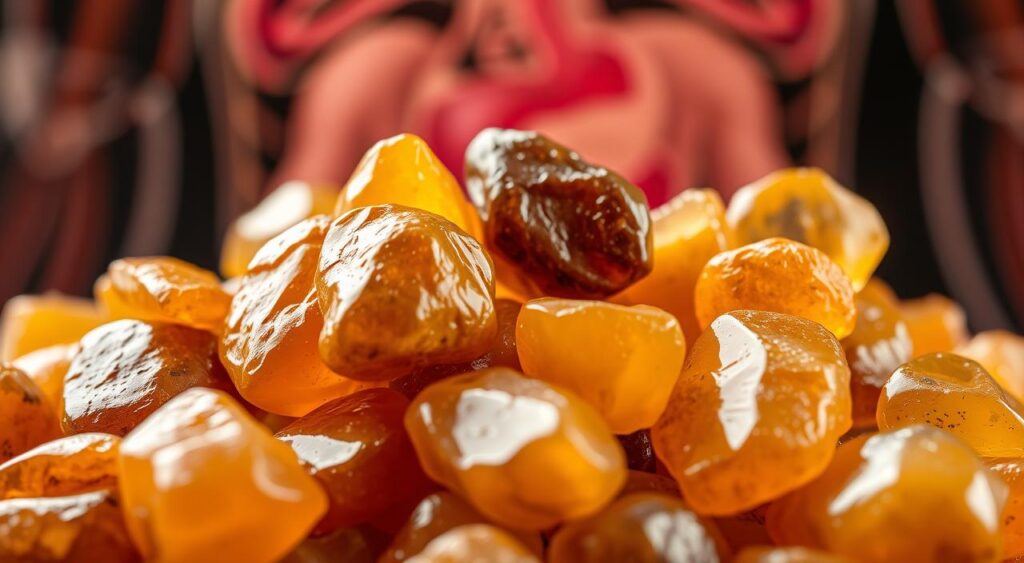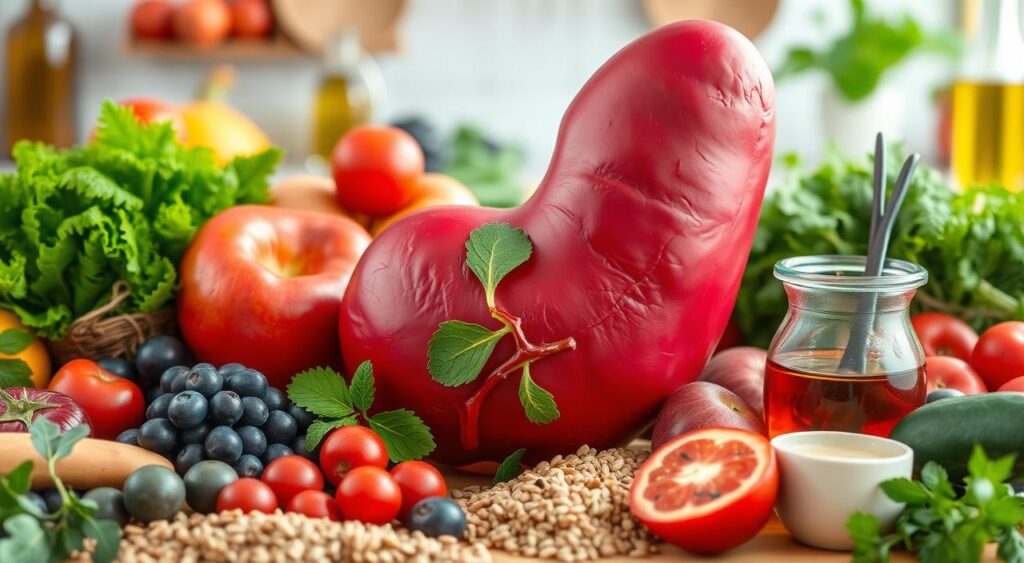Did you know that gallstones affect about 10-15% of adults in the United States? This makes it one of the most common gastrointestinal disorders. This guide explores cholelithiasis, or gallstones, including causes, symptoms, diagnosis, and treatments. You’ll learn about risk factors, prevention, and when to see a doctor for gallstone issues.

Key Takeaways
- Cholelithiasis is a common condition affecting 10-15% of adults in the US.
- Gallstones can cause severe abdominal pain, nausea, and other uncomfortable symptoms.
- Diagnostic approaches include physical examination, laboratory tests, and imaging techniques.
- Treatment options range from medication-based therapies to surgical interventions.
- Adopting preventive measures and lifestyle changes can help reduce the risk of gallstone formation.
Understanding Cholelithiasis (Gallstones): Definition and Formation
Cholelithiasis, or gallstones, is when solid deposits form in the gallbladder. These stones can be different sizes and types. They happen when the balance of substances in the bile gets out of whack.
Types of Gallstones
There are several types of gallstones, each with its own look:
- Cholesterol stones – These are the most common, making up about 80% of gallstones. They are mostly made of cholesterol and are yellow or green.
- Pigment stones – These are dark, usually black or brown, and made of bilirubin, a part of hemoglobin.
- Mixed stones – These have both cholesterol and pigments, making them more complex.
Risk Factors for Stone Formation
Many things can increase your chances of getting gallstones, including:
- Being overweight or losing weight quickly
- Pregnancy
- Diabetes
- Some medications, like hormone therapy or birth control pills
- Genetics
- Being older
- Quick weight loss
Gallbladder Anatomy and Function
The gallbladder is a small, pear-shaped organ under the liver. It stores and concentrates bile, a digestive fluid from the liver. This bile helps digest fats in the small intestine. If the gallbladder is blocked by stones, it can cause problems like bile duct obstruction and cholelithiasis.
Common Signs and Symptoms of Gallstone Disease
Gallstone disease, also known as cholelithiasis, can cause a variety of symptoms. These symptoms can greatly affect a person’s life quality. The most common symptoms include biliary colic, cholecystitis, and gallstone pancreatitis.
Biliary colic is a dull, aching pain in the upper right abdomen or between the shoulder blades. It usually happens after eating a fatty meal. This pain can last for hours but often goes away by itself.
Cholecystitis is an inflammation of the gallbladder caused by gallstones. It brings sharp, persistent pain in the upper right abdomen. Symptoms also include nausea, vomiting, and fever.
- Biliary colic: Dull, aching pain in the upper right abdomen or between the shoulder blades, often occurring after a fatty meal.
- Cholecystitis: Sharp, persistent pain in the upper right abdomen, accompanied by nausea, vomiting, and fever.
- Gallstone pancreatitis: Severe, sudden-onset abdominal pain, often radiating to the back, along with nausea and vomiting.
Gallstones can also cause gallstone pancreatitis. This happens when stones block the pancreatic duct. It leads to severe pain that radiates to the back, along with nausea and vomiting.
| Symptom | Description |
|---|---|
| Biliary colic | Dull, aching pain in the upper right abdomen or between the shoulder blades, often occurring after a fatty meal. |
| Cholecystitis | Sharp, persistent pain in the upper right abdomen, accompanied by nausea, vomiting, and fever. |
| Gallstone pancreatitis | Severe, sudden-onset abdominal pain, often radiating to the back, along with nausea and vomiting. |
“Recognizing the common signs and symptoms of gallstone disease is crucial for seeking timely medical attention and preventing potential complications.”
Early Warning Signs and Diagnostic Approaches
It’s important to spot the early signs of gallstone disease, or cholelithiasis, to get treatment on time. The first step is a detailed physical check-up. Then, various tests and scans help confirm if you have gallstones and how serious they are.
Physical Examination Methods
Doctors check your abdomen to see if it hurts or if they can feel your gallbladder. They might also do a Murphy’s sign test. This test checks for pain in the right upper abdomen, which could mean gallbladder trouble.
Laboratory Tests and Imaging
Tests like liver function tests and a complete blood count can hint at gallstones. Imaging like ultrasound, CT scans, and ERCP help confirm the diagnosis and see how bad it is.
Ultrasound is often the first choice for imaging. It can spot gallstones and check the gallbladder’s health. ERCP might be used to look at the bile ducts and find any complications, like stones in the common bile duct.
Differential Diagnosis Considerations
It’s key to think about other possible conditions when diagnosing cholelithiasis. Symptoms can be similar to other diseases, like pancreatitis or irritable bowel syndrome. A thorough look at your medical history, physical exam, and test results is needed for an accurate diagnosis and treatment plan.
“Early detection and accurate diagnosis are essential for the effective management of cholelithiasis, as it can help prevent serious complications and improve patient outcomes.”
Complications of Untreated Gallstone Disease
Ignoring gallstones can cause serious health problems. Three major issues are cholecystitis, gallstone pancreatitis, and gallstone ileus.
Cholecystitis is when the gallbladder gets inflamed, usually from a blockage. It can cause a lot of pain, fever, and nausea. If not treated, it might even lead to a ruptured gallbladder, which is very dangerous.
Gallstone pancreatitis happens when a gallstone blocks the pancreatic duct. This causes the pancreas to get inflamed. Symptoms include severe pain, nausea, and vomiting. If not treated, it can lead to organ failure and even death.
Gallstone ileus occurs when a gallstone gets stuck in the intestine. This causes a blockage. Symptoms include severe pain, vomiting, and trouble passing gas or having a bowel movement. It needs immediate surgery to avoid more problems.
| Complication | Symptoms | Potential Consequences |
|---|---|---|
| Cholecystitis | Abdominal pain, fever, nausea | Ruptured gallbladder, life-threatening emergency |
| Gallstone Pancreatitis | Severe upper abdominal pain, nausea, vomiting | Organ failure, death |
| Gallstone Ileus | Severe abdominal pain, vomiting, inability to pass gas or have a bowel movement | Bowel obstruction, requires immediate surgical intervention |
These complications show why it’s crucial to get medical help for gallstones quickly. Early treatment can prevent these serious and potentially deadly issues.

Medical Treatment Options and Management Strategies
People with gallstones or gallbladder disease have many treatment options. These aim to fix the problem, ease symptoms, and stop more issues.
Medication-Based Treatments
Ursodeoxycholic acid is a key medicine for gallbladder disease. It dissolves cholesterol gallstones, especially small ones. It’s good for those who can’t or don’t want surgery.
Lifestyle Modifications
Changing your lifestyle is also important. Keeping a healthy weight, exercising regularly, and eating less fat and cholesterol helps. These steps can stop new gallstones and lower the chance of them coming back.
Dietary Recommendations
- Eat more fiber from fruits, veggies, and whole grains to lower cholesterol and help bowel movements.
- Drink less saturated and trans fats from fried foods, processed meats, and baked goods.
- Drink lots of water to help prevent gallstones by diluting bile.
- Add foods like milk thistle and dandelion greens to your diet for gallbladder health.
Combining medicines, lifestyle changes, and diet can help manage gallbladder disease. This approach can keep symptoms under control and prevent serious problems.
Surgical Interventions: When Is Surgery Necessary?
Surgery is often the best way to treat gallbladder disease in some cases. The most common surgery is a laparoscopic cholecystectomy. This involves removing the gallbladder through small cuts. It usually means less pain and a quicker recovery than traditional surgery.
Here are some reasons you might need this surgery:
- Recurring or severe gallbladder pain (biliary colic)
- Complications from gallstones, like inflammation or blockage of the bile duct
- Gallbladder polyps or other unusual growths
- Gallstones causing pancreatitis (inflammation of the pancreas)
The surgery takes about 1-2 hours and is done under general anesthesia. The surgeon makes small cuts in the abdomen to remove the gallbladder. After removing it, the cuts are closed with stitches or staples.
| Potential Benefits of Laparoscopic Cholecystectomy | Potential Risks and Complications |
|---|---|
| Minimally invasive approach Shorter hospital stay (often same-day discharge) Faster recovery time Reduced post-operative pain and scarring | Bleeding Infection at the incision site Bile duct injury Gallbladder perforation during removal |
Laparoscopic cholecystectomy is usually safe and effective for gallbladder disease. But, like any surgery, there are risks and complications. It’s important to talk to a healthcare provider about the benefits and risks. They can help decide if surgery is right for you.
Recovery and Post-Treatment Care Guidelines
After gallstone treatment, like laparoscopic cholecystectomy, recovery is usually smooth. Knowing the recovery timeline, dietary changes, and long-term care is key for a good outcome.
Post-Surgery Recovery Timeline
Most patients can get back to normal in 1-2 weeks after a laparoscopic cholecystectomy. There might be some discomfort, but it can be managed with pain meds and rest. It’s important to watch your incision sites and avoid hard activities early on.
Dietary Changes After Treatment
After gallbladder removal or treatments for gallstones, diet changes are needed. A low-fat diet is often advised because high-fat foods can be hard to digest. It’s best to eat smaller, more frequent meals instead of big, heavy ones.
Long-term Management Strategies
To avoid gallstones coming back or other problems, long-term care is important. Keeping a healthy weight, staying active, and watching what you eat are key. Also, regular check-ups with your doctor are crucial for managing gallbladder disease.
| Recovery Timeline | Dietary Changes | Long-term Management |
|---|---|---|
| 1-2 weeks to resume normal activities | Low-fat diet, smaller, more frequent meals | Maintain healthy weight, stay physically active, monitor dietary intake, regular check-ups |
Understanding recovery, diet changes, and long-term care helps patients have a smooth recovery after gallstone treatment. This includes laparoscopic cholecystectomy, and it helps prevent more gallbladder disease problems.
Prevention Strategies and Lifestyle Changes
Dealing with cholelithiasis (gallstones) can be tough, but there’s hope. You can lower your risk by making smart choices. By being proactive, you can keep your gallbladder healthy and avoid gallstones.
Your diet is a big part of the solution. Eat foods high in fiber to help your bowels move regularly. This can lower your chance of getting gallstones. Eat lots of fruits, veggies, and whole grains. Also, cut down on saturated and trans fats, which can harm your gallbladder.
- Eat more fiber-rich foods, like:
- Whole grains
- Legumes
- Leafy greens
- Berries
- Drink less of saturated and trans fats, found in:
- Fried and fatty foods
- Processed meats
- Baked goods
Keeping a healthy weight is also key. Being overweight can raise your risk of gallstones. Stay active with activities like walking, swimming, or cycling. This helps manage your weight and keeps your gallbladder healthy.
“Regular exercise and a balanced diet can go a long way in preventing the formation of gallstones.”
Also, drink plenty of water and limit alcohol. Both can affect your gallbladder. By following these tips, you can lower your risk of cholelithiasis and keep your gallbladder in good shape.

Alternative Therapies and Complementary Treatments
Some people with cholelithiasis (gallstone disease) look for other ways to feel better. They might try alternative or complementary therapies. These methods can help manage gallstones and gallbladder disease alongside traditional treatments.
Natural Remedies
Many natural remedies are being studied for their benefits on the gallbladder. These include:
- Herbal supplements like milk thistle, dandelion root, and artichoke leaf. They might reduce inflammation and help with bile production.
- Digestive enzymes can help break down and get rid of gallstones.
- Castor oil packs are thought to help detoxify the gallbladder and liver.
But, it’s key to remember that these remedies aren’t proven to work for everyone. Always talk to a doctor before trying them.
Holistic Approaches
Holistic treatments aim to treat the whole body, not just the gallbladder. These might include:
- Acupuncture tries to balance energy and improve overall health.
- Meditation and stress management can lessen stress’s effects on the body and boost the immune system.
- Dietary changes like eating more fiber and healthy fats might help prevent and manage gallstones.
Before adding holistic methods to your gallstone treatment plan, talk to a healthcare expert. This ensures they’re safe and effective for you.
“Integrative approaches can provide a complementary way to manage gallbladder health and support the body’s natural healing processes.”
Conclusion
Gallstone disease, or cholelithiasis, is a common issue affecting millions globally. Knowing how gallstones form and what causes them is key to early treatment. This article has covered the signs, how doctors diagnose, and the risks of not treating gallstones.
There are many ways to manage gallstone disease, from medicines to surgery. Sometimes, surgery is needed to fix the problem. It’s also important to focus on recovery and making healthy lifestyle choices.
Preventing gallstones is possible with the right lifestyle. Understanding treatment and prevention can help keep your gallbladder healthy. Always talk to a doctor for advice on managing and preventing gallstone issues.
FAQ
Q: What is cholelithiasis?
A: Cholelithiasis, also known as gallstones, is when solid deposits form in the gallbladder or bile ducts.
Q: What are the common symptoms of gallstone disease?
A: The main symptom is biliary colic, a sharp pain in the upper right abdomen. It can spread to the back or right shoulder. Other signs include nausea, vomiting, and indigestion.
Q: How are gallstones diagnosed?
A: Doctors use physical exams, lab tests, and imaging like ultrasound, CT scans, or ERCP to find gallstones.
Q: What are the risk factors for developing gallstones?
A: Being female, overweight, or obese increases your risk. So does rapid weight loss, pregnancy, diabetes, and cirrhosis.
Q: When is surgery necessary for gallstones?
A: Surgery, like laparoscopic cholecystectomy, is often needed for severe cases. This includes acute cholecystitis, gallstone pancreatitis, or bile duct blockage.
Q: How can gallstones be prevented?
A: To prevent gallstones, keep a healthy weight, eat a balanced diet, and exercise. Sometimes, doctors prescribe ursodeoxycholic acid to prevent stones.
Q: What are the potential complications of untreated gallstone disease?
A: Untreated gallstones can cause serious problems. These include acute cholecystitis, gallstone pancreatitis, and gallstone ileus, where a stone blocks the intestines.
Q: What are the dietary recommendations for individuals with gallstone disease?
A: People with gallstones should eat less fat and cholesterol. More fiber and staying hydrated are also good. Always talk to a healthcare professional about your diet.
Q: Can alternative therapies help manage gallstone symptoms?
A: Some people find relief from natural remedies like herbal supplements or acupuncture. But, there’s not much scientific proof of their effectiveness.
